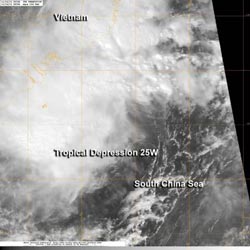NASA satellite sees newborn Tropical Depression 25W raining on southern Vietnam

NASA's Aqua satellite passed over newborn Tropical Depression 25W on Nov. 14 at 0638 UTC (1:38 a.m. EDT) as its northern edge was bringing rains and gusty winds over southern Vietnam.<br><br>Credit: NASA/NRL<br>
When NASA's Aqua satellite passed over newborn Tropical Depression 25W (TD25W) on Nov. 14 at 0638 UTC (1:38 a.m. EDT), the Moderate Resolution Imaging Spectroradiometer (MODIS) instrument captured a visible image of the storm.
At the time of the image, the strongest thunderstorms appeared to be over the Long Khanh District, northwest of Vung Tau and Ho Chi Minh City.
On Nov. 14 at 1200 UTC (7 a.m. EDT) TD25W had maximum sustained winds near 25 knots (28.7 mph/46.3 kph). It was centered near 8.3 North latitude and 106.6 East longitude, about 160 nautical miles (184.1 miles/296.3 km) south of Ho Chi Minh City, Vietnam. TD25W is moving to the west-northwest at 14 knots (16.1 mph/26 kph).
TD25W is currently battling moderate wind shear, and its convection has waned during the early morning hours on Nov. 14. The depression is expected to remain loosely organized over the next couple of days.
TD25W is forecast to move through the Gulf of Thailand, cross southern Thailand and move into the Andaman Sea.
Media Contact
More Information:
http://www.nasa.govAll latest news from the category: Earth Sciences
Earth Sciences (also referred to as Geosciences), which deals with basic issues surrounding our planet, plays a vital role in the area of energy and raw materials supply.
Earth Sciences comprises subjects such as geology, geography, geological informatics, paleontology, mineralogy, petrography, crystallography, geophysics, geodesy, glaciology, cartography, photogrammetry, meteorology and seismology, early-warning systems, earthquake research and polar research.
Newest articles

Why getting in touch with our ‘gerbil brain’ could help machines listen better
Macquarie University researchers have debunked a 75-year-old theory about how humans determine where sounds are coming from, and it could unlock the secret to creating a next generation of more…

Attosecond core-level spectroscopy reveals real-time molecular dynamics
Chemical reactions are complex mechanisms. Many different dynamical processes are involved, affecting both the electrons and the nucleus of the present atoms. Very often the strongly coupled electron and nuclear…

Free-forming organelles help plants adapt to climate change
Scientists uncover how plants “see” shades of light, temperature. Plants’ ability to sense light and temperature, and their ability to adapt to climate change, hinges on free-forming structures in their…





















